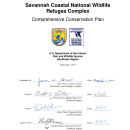What We Do
Invasive Species Management
In recent years, invasive, exotic plants and animals have become a serious threat to national wildlife refuges throughout the United States. Each year, three million acres of land are lost to exotic, invasive plants, and billions of dollars are spent battling their infestation. Chinese tallow tree, water hyacinth, and alligator weed are species from another area – often from another continent – that have been introduced here, locally. They reproduce rapidly, have few predators, and have low food value for wildlife.
On Blackbeard Island, feral hogs have become one of the most problematic invasive species invasive species
An invasive species is any plant or animal that has spread or been introduced into a new area where they are, or could, cause harm to the environment, economy, or human, animal, or plant health. Their unwelcome presence can destroy ecosystems and cost millions of dollars.
Learn more about invasive species concerns for refuge staff. These are exotic animals; either domestic pigs that have escaped captivity, Eurasian wild boar (introduced to North America), or a hybrid. They are not a natural part of local ecosystems. They are incredibly destructive to habitatx and a threat to endangered species, like loggerhead sea turtles and piping plovers, due to nest predation. As the hog population continues to grow, management efforts have ramped up from opportunistic removal by refuge staff and deer hunters to a more intense baiting and trapping system.
Prescribed Fire
Fire has shaped the local landscape for eons. Because of the Georgia coast's long history of lightning and man-made fires, natural systems are adapted to fire and depend on frequent fire to remain healthy. Prescribed burning plays a natural role in local ecosystems and is a vital tool for managing public lands. The extraordinarily high diversity of plant species of the coastal ecosystems is maintained by fire, which reduces competition from woody plants and recycles nutrients. One of the greatest benefits of prescribed fire is that it reduces “fuels” – the underbrush, branches, pine needles, leaves, and dead plant debris that have built up on the forest floor. If fuels are not reduced every few years, wildfires become intense, hot, and destructive.
Managed Hunts
Hunting is an important wildlife management tool that we recognize as a healthy, traditional outdoor pastime, deeply rooted in America’s heritage. Hunting can instill a unique understanding and appreciate of wildlife, their behavior, and their habitat needs.
As practiced on refuges, hunting does not pose a threat to wildlife populations, and in some instances are necessary for sound wildlife management. For example, because their natural predators are gone, deer populations will often grow too large for the refuge habitat to support. Hunting programs can promote understanding and appreciation of natural resources and their management on lands and waters in the refuge system.
Blackbeard Island NWR offers three-day archery hunts twice each year. These hunts are open to all properly licensed hunters (no drawing). A $25 refuge hunt permit must be purchased in order to participate. For current hunting regulations and dates, and to purchase a hunting permit, please visit the refuge's hunting web page.
Management and Conservation
Refuges deploy a host of scientifically sound management tools to address biological challenges. These tools span active water management to wilderness character monitoring, all aimed at ensuring a balanced conservation approach to benefit both wildlife and people. At this field station our conservation tool box includes:
Planning – Comprehensive Conservation Plan
Climate Resilience
Compatibility Determinations
Cultural Resources
Education & Outreach
Fire Management
Human Dimensions
Invasive Species
Inventory and Monitoring
Law Enforcement
Recreation Management
Species Research
Wildlife Health
Wilderness Character Monitoring
